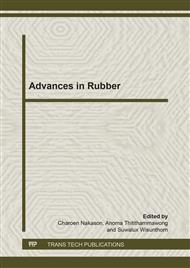p.105
p.109
p.113
p.117
p.122
p.127
p.131
p.135
p.140
Assessment of Mixing Efficiency of Intermeshing Rotor Mixers on Morphological and Mechanical Properties and Crosslink Density of Dynamically Vulcanized EPDM/PP Blends
Abstract:
The mixing efficiency of intermeshing rotor internal batch mixers for the preparation of rubber-rich thermoplastic vulcanizates (TPV) based on ethylene propylene diene terpolymer (EPDM) and polypropylene (PP) blends was investigated. Two laboratory scale mixers, namely intensive batch mixer (INS) and kneader batch mixer (KND), were used. The mixer choice at controlled mixing conditions was investigated to determine its effects on morphological and mechanical properties and crosslink density of the prepared EPDM/PP TPVs. Such effects were found on the degradation of the polymer, on the distribution of the EPDM phase in the blend morphology, particularly the size of EPDM inclusion, and on the crosslink density of the EPDM phase. In summary, the different mixing efficiencies of INS and KND type mixers affect the EPDM/PP TPVs and their properties. Also, the INS mixer has higher mixing efficiency than the KND mixer.
Info:
Periodical:
Pages:
122-126
Citation:
Online since:
November 2013
Price:
Сopyright:
© 2014 Trans Tech Publications Ltd. All Rights Reserved
Share:
Citation:


